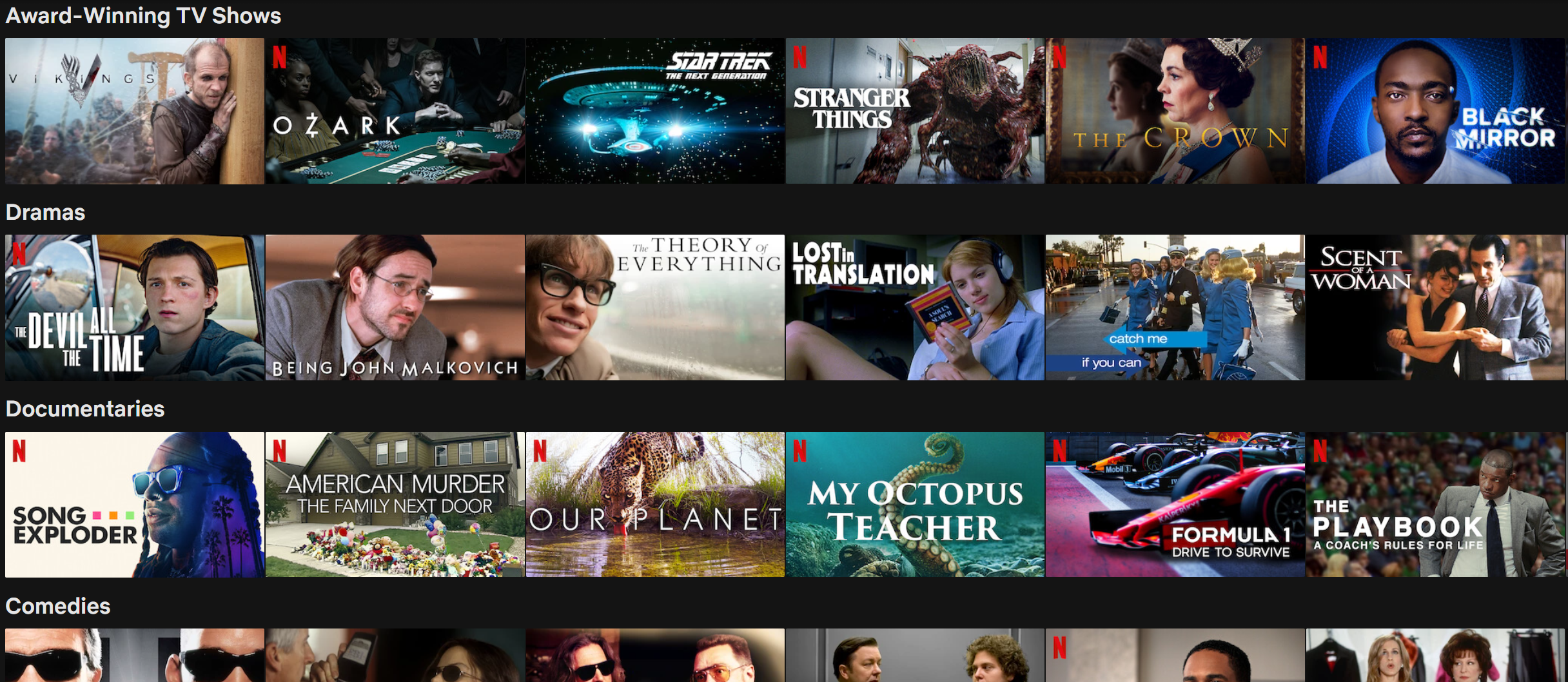
Anyone who has even the slightest idea of film production can laugh now. After a string of #metoo scandals that continue to uncover the deeply corrupt fabric of Hollywood and its surrounding spaces, it's hard to take Star Trek-style tales of iridescent budgeting tools seriously. These stories, moreover, are completely devoid of specifics - Netflix is known for its unwillingness to disclose the real ratings of its products, so a six-sided cube can prompt artistic solutions to their manufacturers with the same success. Which, of course, does not mean that work in this direction is not being carried out. Moreover, not only Netflix and other giants, but also small companies are trying to build their business model on machine predictions.

In general terms, the process is arranged as follows - specially hired people watch a large number of popular and random films and TV series, noting their numerous features - filmed by a woman, lasts 98 minutes, there is no physical violence, there are no stars, the budget is such and such, fees are such and such, the action takes place in New York (and further - as far as the imagination of the direct performers and their managers allows). In parallel with this, all kinds of open sources of structured information such as IMDB and the Internet in general are analyzed for viewer reviews, keywords and other connections with the outside world. Further, algorithms specific to specific tasks come into play, but, if we simplify, then modern machine learning in this area is increasingly reduced to solving the problem of continuing the sequence.
What needs to be done when one, the other and the third have already been done. The most obvious example of such a task can be considered the generation of text, and the most promising solution at the moment is the GPT-3 model, which can take into account more than 170 billion parameters. The last figure, of course, sounds a bit comical - the mathematical context and modern models of the human brain impose their own standards, but among other things, we are talking about someone slipping on a banana peel for the amusement of the public.
In theory, this is, of course, a way to write scripts automatically, as well as automatically shoot (and watch) them. In practice, people still write and shoot movies, but if we talk about Netflix, machines still solve some of the traditionally human artistic tasks. According to the company's employees, artificial intelligence is used to create trailers, posters, as well as at some stages of installation. Returning to the issues of pre-production and the thoughts of the producers, Netflix claims that they have tools at their disposal to find locations for filming, as well as to form film crews, based on the schedules of employment of certain people. It should be borne in mind, however, that a content producer for Netflix, if he managed to become one,and without special tools, it has a huge number of privileges - the schedules of actors and lighting fixtures, although a serious thing, are still capable of adapting to the needs of people with money and reaching a large audience.

Yet Netflix's main pride as a technology company today is its recommendation system. There are reports of 80% of Netflix's commercially successful projects due to the way films and TV series connect with potential audiences - that is, 4 out of 5 films and TV series produced by the company are beating costs. we will leave the details of how - and whether it is possible at all - to prove this when paying for a subscription to the entire catalog, something else is more interesting. Namely, how these recommendations are arranged. In general, there can be no novelty about the activity of, say, a tent with videotapes from the 90s. The only question is how deep we are ready to dive.
It doesn't take a lot of brain and machine power to put Friends on the front page, but no company that ever aired Friends before Netflix was valued at $ 26 billion. No joke, in March the company was forced to reduce the bandwidth of its European channels by 25% so that the Internet would not break. With all the possible skepticism about what the company builds its public image on, it is difficult to deny the obvious - a huge number of people do not just watch TV shows, but watch Netflix specifically.

A key concept for Netflix (and, of course, many others) in terms of business organization is user behavior. If you think a little about what the behavior of a person who watches Internet TV is, a fairly simple set of actions pops up in your imagination - go to the site, scroll through the main page, click somewhere, go back, choose something, look at something , sometime stop, renew or cancel your subscription and so on. Of course, all these and many other activities are monitored and analyzed. And when superimposed on the above-briefly described array of all kinds of tags that mark movies and TV shows, they turn into an unprecedented collection of data on who and how watches Netflix products. And on the basis of this base, the invention of the "next actions" of the company occurs around the clock.
Everything from licensing content to showing it on the viewer's phone is somehow tied to this data. As more data grows and algorithms for handling them improve, a scenario in which even in our century the task of producing a film can be completely entrusted to the world of robots does not seem unattainable. And it is this, albeit conditional (what kind of films will they be?) Realism that ensures the continuous growth of all Netflix's indicators as a business. However, there are also countless constraining factors, of which I would like to dwell on one in detail - the resistance of the material.
In recent years, not a single conversation about the fate of video on the Internet can be complete without mentioning the social network TikTok. Short videos from all over the world spin at incredible speeds and an incredible number of smartphones (we are talking about a billion) at the behest of, it would seem, all the same algorithms. But Tiktok (and in this sense, we can talk about YouTube) is not only a billion users, but about the same number of videos. Moreover, the videos are so short that it is just right to talk about attempts at their expense not even to grab attention, but to directly turn on specific neurons in the viewer's brain. But since the viewer in this case is almost equal to the creator, that is, the producer, analytical tools are much more transparent in his case, and in fact - their ephemerality.
Yes, tags, yes, the number of views and similar numbers, coupled with demographic data about viewers - all this can be applied and build your tiktok empire, but by and large, tiktok remains too fast a spinning carousel of images for some kind of business approach. interesting to talk about. Tiktok thus turns out to be, first of all, proof of the ability to build connections between millions of people, along the way, entertaining them - or informing about something important. And in fact, this is no different from what the same Netflix does. Except for one thing - Netflix shows movies and TV shows, which are things too deeply rooted in the dramatic structures and speeds of the past. While Al Pacino goes from the restaurant table to the toilet, you can watch 4 tiktoks.

Those several thousand films and TV shows available at every moment on Netflix cannot provide the same consumption model as Tiktok or even Youtube. Firstly, TV shows, even the shortest ones, are still not the product of a specific platform assigned to a brand. At the same time, short videos produced and downloaded by ordinary users are like chess games or, more often, individual moves in them - that is, cases in a special world, even if this world equalizes sleeping cats and politicians arguing with each other. ...
Tiktok, of course, would not have appeared without many years of filming video on mobile phones, but what this social network is filled with today is primarily the products of the desire to create a video for Tiktok, only with a special angle of view that can outgrow the original context. It's different with Netflix. The series "Black Mirror" cannot be equal to "The Godfather" not because one work is better than another, but because they are banally too long so as not to lose the formal connection with each other by the end credits. Netflix certainly marks the status of convenience - in the everyday sense: the house has hot water and Netflix.
But, let's be honest, hot water is a little simpler. Dozens and hundreds of actors, sets, camera passes, roll-overs with the surrounding reality and even associations that arise about viewing - all this together does not produce an effect comparable to hot water in unambiguity. The secret that content producers guard best sounds like this - if you watch all the series in the world, there will be absolutely nothing. And yes, perhaps 18 years ago it was possible to tell by facial expressions whether a person watched yesterday's episode of The Brigades or not, but in the situation of a super-personalized matrix of Internet services in the morning, one can only hope for the ability to roughly understand how many hours a person slept.Therefore, the ability to imagine the situation of the existence of automatic cinema can be equated to the possibility of not imagining anything at all - and the victory of machines will happen much faster through tiktok.
This logic, of course, fails if Netflix is perceived as a machine for the production of particulars - for example, if a person has reached such a level of organization of his life, at which he needs only one episode of a relatively good comedy series from television per day, then it is easier to start Netflix now to the budget for life. But if you look at Netflix's policy or at least its home page, it becomes obvious that the company is betting primarily on the person who would like to make a choice - hence all the experiments with the formation of categories, thumbnails, trailers and other means of self-expression in a rather primitive model a free market created with the latest technology. Objects of the Netflix catalog are in endless competition with each other - and in general, that's all,what you need to know about the structure of this platform - just like about the device of many others.

Yes, strictly speaking, serials do not make a person either cleaner or smarter, therefore they should be produced, since, in principle, so popular, should be as dust-free as possible. However, belonging to a certain community and, if you will, morality can make a person smarter and cleaner - and here, as a cultural product, TV shows certainly have something to say - primarily because there is something to say to their creators. The uniqueness of the current situation is that this conversation has incredibly accelerated and grown in scale. But, as we can see in comparison with Tiktok, Netflix may not be able to cope with exactly the increasing speed - but who knows, maybe the audience will no longer cope with it, and the passage by that time of the forgotten actor from one part of the restaurant to another will be what will keep the world at a speed comfortable for existence.

